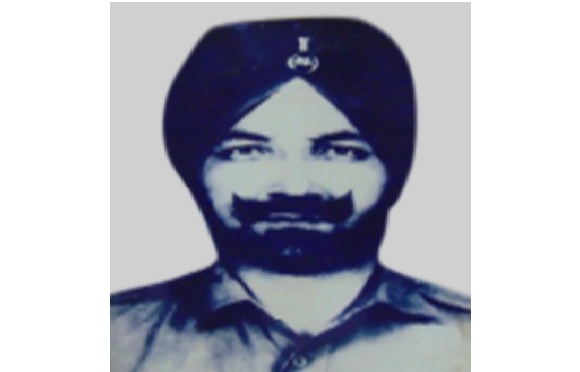In 1971, Sub Gurcharan Singh's unit 10 Sikh was deployed in the Rajasthan Sector under the command of Col SD Mehta. By October 1971, 11 Division of the Indian Army’s Southern Command was concentrated in Rajasthan’s Barmer sector with two brigades and a tank squadron (14 T-55 tanks). Tasked with capturing Naya Chor by advancing along the Gadra Road–Munabao axis, its subsidiary operations targeted Khinsar and Chachro. Over the course of the war, the division captured over 9,000 sq. km of Pakistani territory—one of the largest territorial gains of the conflict—earning multiple battle honours, including Parbat Ali, and producing two Maha Vir Chakras and 26 Vir Chakras. Within this campaign, 85 Infantry Brigade advanced northward, spearheaded by 10 Sikh Light Infantry, which rapidly cleared enemy outposts. Major resistance came at Gazi Camp and Kaljor, but Indian artillery demolished fortified bunkers, paving the way for deeper advances. By 5 December, Khokropar railway station was secured, opening the axis to Nayachor.
The fiercest fighting occurred at Parbat Ali, a 200-foot-high U-shaped dune dominating Nayachor’s approaches. Heavily mined and defended by Pakistan's 21 and 39 Frontier Force Rifles, it was a formidable stronghold. On the night of 12/13 December, 10 Sikh and 2 Mahar launched a daring assault from the steep “knuckle end,” catching the enemy completely off guard. Supported by feint attacks, an outflanking tank manoeuvre, and devastating artillery fire, the assault overwhelmed Pakistani defences by 0400 hours. When the enemy began regrouping for counterattacks, Subedar Gurcharan Singh, commanding a forward platoon, was entrusted with the critical task of assaulting and capturing a heavily fortified enemy position at Parbat Ali. The objective was critical, but the approach to it was fraught with danger—between his men and the enemy lay a 600-metre-deep minefield. Displaying exceptional courage and resolve, Sub Gurcharan Singh led his platoon across the treacherous minefield, inspiring his soldiers by his own fearless example. Under his determined leadership, the platoon pressed on and engaged the enemy in intense hand-to-hand combat, ultimately overrunning the position and securing the objective.
As the platoon began reorganizing on the newly captured ground, Subedar Gurcharan Singh quickly assessed the battlefield situation. His sharp observation revealed two enemy companies assembling nearby, preparing for a counter-attack to reclaim their lost position. Realizing that any hesitation could allow the enemy to regain the initiative, he made a bold and decisive choice. Without waiting for reinforcements or giving the enemy time to advance, Subedar Gurcharan Singh rallied his men and personally led a fierce charge against the assembling forces. The suddenness and ferocity of the assault caught the enemy completely off guard. Taken by surprise, their formation broke apart in confusion, forcing them to retreat in disarray and abandon their planned counter-attack. During this gallant action, Subedar Gurcharan Singh was mortally wounded. Even in his final moments, he exemplified unflinching bravery and devotion to duty—dying as he had fought, leading from the front. In the same battle, his comrade Naik Gurjant Singh displayed extraordinary courage, bayoneting seven enemy soldiers before being killed.
By 1000 hours on 13 December, Parbat Ali was fully secured after a fierce and bloody engagement characterized by bayonet charges and violent hand-to-hand combat fought trench to trench. The gallant 10 Sikh Battalion emerged triumphant in the Battle of Parbat Ali, earning six Vir Chakras, three Sena Medals, and six Mentions-in-Dispatches for their extraordinary bravery and determination. The enemy, badly mauled, retreated leaving behind 57 dead, 35 prisoners, and a huge quantity of arms and ammunition. In addition to Subedar Gurcharan Singh, eleven other gallant soldiers made the supreme sacrifice during the entire operation. Among them were Naik Gurjant Singh, Lance Naik Joginder Singh, Lance Naik Dayal Singh, Sepoy Jaswant Singh, Sepoy Ranjit Singh, Sepoy Gurmit Singh, Sepoy Nachhattar Singh, Sepoy Shangara Singh, Sepoy Gurdev Singh, and two soldiers both named Sepoy Balwinder Singh.
Through his exceptional courage, quick decision-making, and inspiring leadership, Subedar Gurcharan Singh not only ensured the success in the battle but also upheld the finest traditions of the Indian Army and the Sikh Regiment. Sub Gurcharan Singh was given the nation’s third highest gallantry award, “Vir Chakra” for his outstanding courage, unyielding fighting spirit and supreme sacrifice during the operation


Jashandeep
2025 at 8:29 pmI belongs to S gurcharn singh’s family. I can help you to gather some information. You are welcome to contact me via email or phone call. I live in New zealand.